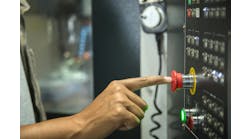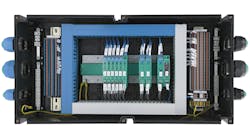A Control Design reader writes: I’m seeing new technologies available for wireless e-stops, remote e-stops and touchscreen e-stops. Are these allowable? Are there regulations governing the use of anything besides a physical red button? What machine applications would these be used for? What does the Occupational Safety and Health Administration (OSHA) say about them? And where is the reset to resume operation?
Answers
Pushbutton standards specify physical requirements
Yes, wireless e-stops and remote e-stops are allowable but must be compliant with the following:
- International Organization for Standardization (ISO) 13849—Safety of Machinery Package
- ISO 13850:2015 Safety of Machinery—Emergency Stop Function—Principles for Design
- American National Standards Institute (ANSI) B65.1-2005—Graphic Technology—Safety Standard—Printing Press
- International Electrotechnical Commission (IEC) 60204-1:2005 Safety of Machinery—Electrical Equipment of Machines—Part 1: general requirements
- IEC 62745 Safety of Machinery—Requirements for Cableless Control Systems of Machinery. This standard aims to define the guidelines of how wireless remote-control systems must be designed to comply with the minimum requirements of machine design and safety.
For touchscreen e-stops, graphical representations of a button—an icon—on an HMI or flat panel display are not an option. The same standards do not permit flush or membrane-style switches or touchscreen buttons/icons.
Yes, regulations are governing the use of anything besides a physical red button. For emergency-stop pushbuttons to be compliant, they must be designed as follows:
- with direct opening operation
- as self-latching and must be reset manually
- with mushroom-head shape to make it easy to push
- to remain unguarded
- to be located at each operator control station and at any other location where an emergency stop would be required
- colored red and mounted on a bright yellow background. The yellow background must be a minimum of 3 mm beyond—surrounding—the mounting collar and visible beyond the control actuator—the button itself—according to ANSI B65.1-2005.
A common application where wireless e-stops are superior to wired e-stops is during crane operations. This allows greater operator freedom for their positioning to view crane movements, and lower costs for system implementation. The wiring alone, in a traditional wired e-stop system, can be a significant portion of the cost and complexity of an e-stop-based safety system implementation.
OSHA and relevant standards such as IEC 60204-1 state that an e-stop must be readily accessible to the operator. Additionally, it should be unobstructed—no collars or actuation restrictions—and easily accessible without having to reach over, under or around to actuate. Machine-building standards such as ANSI B11, B11-19 and National Fire Protection Agency (NFPA) 79 also address specifics in regard to safety devices such as an e-stop.
OSHA and relevant standards such as IEC 60204-1 further state that resetting of the e-stop alone shall not resume operation. A second deliberate action is needed, such as the pressing of a reset button. This could include twisting the mushroom button and allowing it to spring back up or pulling the button back up to reset. It cannot automatically reset.
Michael Warren / product manager—safety components and safety controllers / Omron
Wireless e-stops enhance maintenance safety
After looking through OSHA regulations and other global standards, I could not find anything that specifically says wireless e-stops are not allowed. In fact, there is an offering for a wireless e-stop that actually meets ISO 13849 Category 3 specifications for functional safety systems. There isn’t much in the way of where an e-stop button should be located and what it should look like other than “easily accessible and within arm’s length,” red button on a yellow background and requiring only a manual reset.
OSHA uses NFPA and other global standards, such as ISO, to form its standards. NFPA 79—Electrical Safety Standard for Industrial Machinery—sets out what is allowable for emergency-stop buttons. This includes pull-cord-operated, foot-operated, push-bar-operated and rod-operated switches. NFPA 79 does not allow emergency stops to be flat switches or a graphical/digital representation. So, while wireless e-stops would be allowable, touchscreen e-stops would not be.
Any machine or process could theoretically use a wireless e-stop. More specifically, imagine a scenario where a technician has to be physically inside a machine or is working on a section of the machine where the e-stop might be just out of reach. Having a wireless button that can stop the machine from anywhere would be a great benefit. Another scenario could be operators that keep wireless buttons on their person for potential need. They see someone who shouldn’t be operating or performing maintenance on a machine. It takes time to get to the nearest button to e-stop the machine so being able to press one that’s currently with them on hand could potentially save a life or limb.
The wireless button would need to have a manual reset, whether that be a twist-to-release or a pull-to-release function. Once that’s done, assuming the safety system is a manual/manual, monitored setup, the resume operation would be as usual. Press the reset button. If the safety system is an automatic reset, manually releasing the e-stop button would reset the safety system to a ready state. Most likely, the machine itself will need to be rehomed and/or have the process reset/acknowledge button pressed to restart the production process.
Noah Greene / product specialist—safety / Phoenix Contact USA
E-stop differs from an emergency-off switch
The short answer is yes. Wireless and remote e-stops are allowed with very strict regulations. The standards that dictate how an e-stop switch works are ISO 13850:2015, Safety of Machinery – Emergency Stop Function—Principles for Design; and IEC 60947-5-5, Low-Voltage Switchgear and Controlgear—Part 5.5: Control Circuit Devices and Switching Elements—Electrical Emergency Stop Device with Mechanical Latching Function.
These standards require a physical e-stop that opens a contact and, at the same time, latches. This means no latching without opening the contact and no opening without latching is allowed. ISO 13850 is the so-called machinery directive, which lists several other requirements for operating and resetting an e-stop.
It is important to note that there must be a physical e-stop, no matter what (Figure 1). A physical e-stop, which must open a physical contact, could be connected to a wireless or remote technology to activate it. It sends a signal, and the physical freeze of a machine is activated. It’s also important to note the difference between an e-stop and an emergency-off switch. While an e-stop freezes the machine, an emergency-off shuts off the power, which is not necessarily the case for e-stops.
When it comes to resetting or resuming operation, there are safety regulations and protocols in place. For example, you are allowed to connect a normal-stop switch in a way that, if you push it, the machine stops or freezes. Once you release it, the machine runs again. That is for a normal-stop switch. However, with an e-stop, once you press it, the machine freezes and stops. If you release the emergency-stop switch, the machine must not run, it will stay stopped. For safety reasons, there must be another separate mechanism to restart the machine.
Reinhard Kalla / principal product manager / EAO
Touchscreen e-stops are not allowed
E-stops shall be located at each operator control station. In addition, other locations can be considered according to a risk analysis, including entrance and exit location. See ISO 13850-4, Safety Requirements; 3, Terms and Definitions; and 2, Normative References. In case of e-stop activation, locally or remotely, the machinery shall be inspected in order to detect the reason for activation.
Wireless e-stops are allowed, but, according to the IEC 60204-1, the wireless e-stop shall not be the sole means to initiate an emergency stop. In addition, according to ISO 13850, a wireless e-stop shall comply with Subsection 4.3.8, Subsection 4.3.9, Subsection 4.6.2 and a minimum of safety level PLC, according to ISO 13849, and/or SIL 1, according to IEC 62061. The safety level shall be consistent with a risk analysis of the machine. IEC 62745 deals with wireless control systems for electrical equipment of machinery, and, since March 2021, it is now harmonized for machinery directive in Europe.
Touchscreen e-stop is not allowed, because ISO 13850 and IEC 60947-5-5 require that the emergency-stop device shall comply with IEC 60947-5-1, Annex K, a direct opening action of the electrical contact. A touchscreen is not compliant with this requirement.
According to NFPA 79 10.7.2.3, emergency-stop switches shall not be flat switches or graphic representations based on software applications.
In Europe, in compliance with Machinery Directive, in Annex 1, Subsection 1.2.4.3, emergency-stop machinery must be fitted with one or more emergency-stop devices to enable actual or impending danger to be averted.
The following exceptions apply for:
- machinery in which an emergency-stop device would not lessen the risk, either because it would not reduce the stopping time or because it would not enable the special measures required to deal with the risk to be taken
- portable handheld and/or hand-guided machinery.
For the e-stop, the NFPA standard is more suitable than OSHA regulations. The main requirements of the e-stop are defined in NFPA 79 standard for machinery. The requirements from NFPA 79 are based on IEC 60204-1 with some few specificities for the e-stop.
In case of e-stop activation, locally or remotely, the reset button shall be located in general in the machine, because the machine shall be inspected to detect the reason for activation.
Eric Domont and Sébastien Chaigneau / standardization manager, e-stop expert and creation manager, safety expert / Schneider Electric





